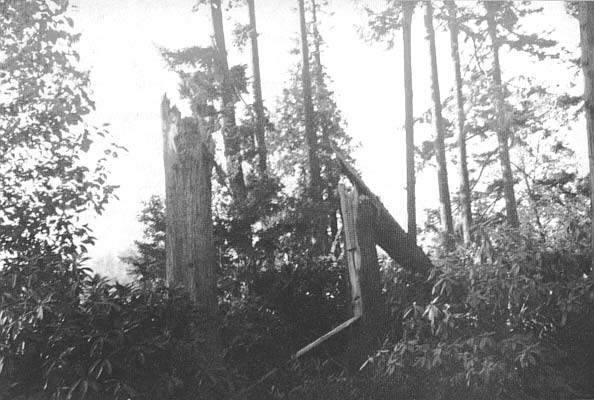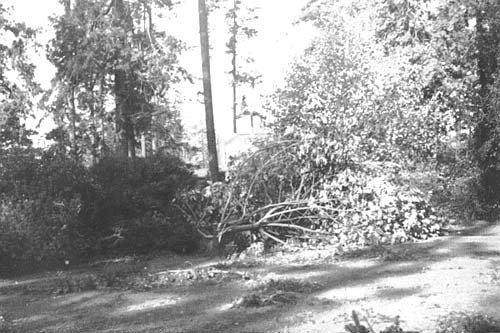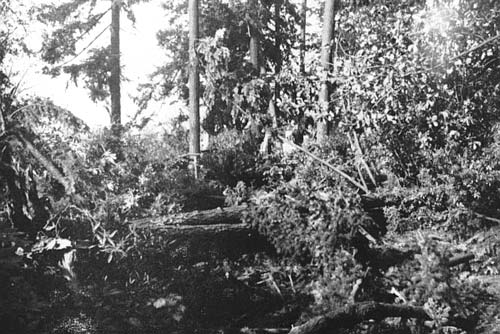QBARS - v17n1 The Typhoon - Report On The National Test Garden
The Typhoon - Report On The National Test Garden
Ruth M. Hansen

|
|
Fig. 4. Cedars and Firs snapped by the terrific force of the wind.
Hansen photo |
On the afternoon of Monday, October 15th, my husband and I drove out to the Test Garden, at Crystal Springs. Driving through the City and seeing the downed telephone and electric wires, the boarded up windows in almost every business establishment, debris piled along every curbing, huge advertising signs hanging from their standards was still not enough to brace us for the awful shock we soon encountered as we drove into the parking lot of the Test Garden. Where once stood the beautiful row of Atlantic Cedars, Cederus atlantica var. glauca , now there were only broken stumps. All but one had been twisted, broken off, blown across the lot and dumped down the hill.
Hurrying to the bridge which spans the Entrance Garden, and the little ravine area planted to the big leaved species, we were sickened by what we saw. Not one whole tree had been left standing. Those not completely blown over were literally stripped of their branches, leaving tall stumps with bare sticks protruding from the main trunks. The large native Big Leaf Maple, Acer macrophyllum which provided shade for the north side of the ravine was completely blown over. Its counterpart on the opposite bank, though standing, was nothing but a naked stump with shattered branches. The ravine itself was so filled with broken branches that it was almost impossible to see any evidence of rhododendron.

|
|
Fig. 5. Broken stumps of
Cederus atlantica
var.
clauca
and Acer macrophyllum at the entrance of the Test Garden. Hansen photo |
Climbing down into the area we found the big R. rex on its side, so together we pushed it upright but it will have to have a permanent bracing. The big R. auriculatum was badly crushed, perhaps totally destroyed. Other plants were buried beneath such piles of branches that we could not estimate their damage.
After crossing the bridge onto the Peninsula our progress was stopped because of the downed trees. It was necessary to pick our way out through the rhododendron beds and over fallen logs before reaching the foot bridge leading into the Test Garden. We could begin to see something of the complete destruction which met us with full impact as soon as we unlocked the gates and entered the garden. It was like some giant monster had taken a box of match-sticks made of huge fir trees and then dropped them into a pile over our little island. It was impossible to walk so we scrambled up over the fallen giants and where the piles of logs were too great we worked our way around them. And the awful truth that our work of twelve years had apparently been destroyed all within a few short hours was quite evident everywhere we looked. The rockery, buried beneath piles of large branches was positively non-existent. What remained of any of the plants we could not tell. One huge fir lay across a portion of the cyclone fence.
Fortunately the Coolhouse didn't appear to be badly damaged, at least none of the trees had fallen directly on it, though we could see a number of holes broken through the plastic top. Growing in front of the Coolhouse about three feet from the building stands a Douglas Fir, Pseudotsuga taxifolia about 100 feet high; directly to the south of the building grew a similar sized Western Red Cedar, Thuja plicata . The big cedar crashed neatly between the fir and the Coolhouse wedging itself within the three foot space and the only apparent damage we could see to the Coolhouse was that the gutter had been bent and twisted. Had the cedar fallen just one foot to the east it would have taken the entire porch area off the Coolhouse. We were indeed thankful for this act of good fortune.

|
|
Fig.6.
Magnolia
var.
veitchii
lost during the storm.
Hansen photo |
The lawn area in front of the Ghent azalea bed was covered with debris from the fallen Magnolia var. veitchii , the Hawthorne and birch trees, all of which were completely destroyed. Fortunately the Dove tree seems unharmed. The planting to the left of the service gates was severely damaged and until the trees are removed it is impossible to tell how many rhododendrons are destroyed or damaged. Here again the cyclone fencing was crushed.

|
|
Fig. 7. Large fir trees down amongst the rhododendron planting.
Hansen photo |
Perhaps the worst damage of all is on the west side of the Island in the species bed. Here the fallen firs were piled six to eight feet deep. many uprooted leaving their wide spreading pancake-like root system standing on edge. In one instance, about ten feet above us, there supported by the large upturned roots, was an eight foot plant of R. ponticum at a horizontal angle to the ground. But what of the many species buried beneath these tons of logs? We could only guess their fate. The hybrid planting across the path suffered the same crushing blows, perhaps worse since the tops of these trees with their flying branches struck this area.
Hurrying as best we could to see what was left of the planting of big-leaved species. the R. falconeri , eximium , fictolacteum , sinogrande and the big sutchuenense which blooms so beautifully every February, we were wonderfully surprised to find not one plant was damaged, furthermore not one tree had fallen within this planting. Apparently the full force of the wind had struck a few hundred feet to the south thus saving these particular plants from complete destruction.
Just what caused this terrible ruin to the Garden? It was the result of what meteorologists consider to be the end of the tropical hurricane Frieda which had its beginning in the South China Seas. It should have dissipated itself out in the Pacific Ocean but instead it veered suddenly towards land, re-formed and struck first along the northern California coast then proceeded to move quickly northward, destroying everything in its path. Storm warnings were up along the coast and a 60 mile an hour wind forecast was made for the Portland area. Many asked afterwards why there hadn't been better warnings. The answer very simply put was that the strongest wind ever recorded in Portland were 61 miles an hour therefore no one ever imagined that there would be winds of stronger velocity.
At 5:46 P.M. on October 12th. the wind gauge at the Portland Weather Bureau was destroyed with a reading of 85 miles an hour. The gauge on the Morrison Street Bridge recorded 116 miles an hour but the final recordings were 120 miles per hour, almost twice the velocity ever recorded for this area. It was like some awful wild thing let loose, bent upon total destruction to everything within its grasp. The wind was warm, too warm, and striking with such violence it positively shredded and burned the foliage on deciduous trees.
The next morning we awoke to a beautiful calm sunny day, a strange and rather eerie sight after the nightmarish ordeal we had all experienced just a few hours earlier. Now, four weeks after the storm, the City Park Department have had their crews logging out the big trees in the Test Garden and burning the debris. Our own Test Garden crew has worked every Saturday trying to restore order to the gardens and to rescue some of the more severely damaged plants.
It doesn't seem possible that plants with foliage, such as the rhododendrons have, could have survived winds up to 120 miles an hour, yet there is little evidence of any actual wind breakage to the foliage and had it not been for the falling trees there would not have been any plants damaged within these gardens. As it is, among the hybrids we know the large R. 'Sappho,' 'Mrs. A. T. de la Mare', 'Lady Bird' and 'Annie E. Endtz' were completely crushed to the ground, others were almost split in half or have lost most of their branches. The species beds were less fortunate, and at this writing there has not been time to identify those plants completely destroyed. Others, like the eight foot R. auriculatum were stripped of their branches leaving perhaps one bare stem with a whorl of leaves at the very end. The four foot bushy plant of R. metternichii growing at the top of the Rockery has now only a few side branches left. The several R. fortunei and other species south of the service gates will all have to be severely pruned.
Though we regret the loss and damage to the rhododendrons perhaps the greatest regret is the loss of the tall Douglas Firs which have given the Test Garden such a beautiful setting, making it outstanding and different from all other gardens. These trees, 150 to 200 years old, cannot be replaced in our life time and it is fairly safe to say that about one-third of them were either totally destroyed or have had their tops broken. The loss of these trees has changed the entire atmosphere of the gardens making them more open and exposed. Shade, being of paramount importance is now greatly reduced, and the rhododendrons will possibly suffer from this exposure next summer.
